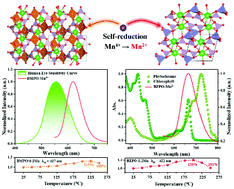Achieving highly thermostable red emission in singly Mn2+-doped BaXP2O7 (X = Mg/Zn) via self-reduction†
Abstract
Non-rare earth doped red phosphors are attracting wide attention for warm-white lighting and indoor plant cultivation applications. Mn2+-doped phosphors have good spectral tunability and great potential to generate red emissions with comparable spectral profiles to commercial materials but with poor thermal resistance. Herein, two kinds of Mn2+-doped BaXP2O7 (X = Mg/Zn) red-emitting phosphors are produced via self-reduction in air. The XPS, EPR, and optical spectroscopy measurements confirm the stabilization of manganese in the divalent state Mn2+. The BaMgP2O7:Mn2+ (BMPO:Mn2+) phosphor has an emission band at around 620 nm, matching well with the photopic spectral luminous efficiency curve. BaZnP2O7:Mn2+ (BZPO:Mn2+) exhibits a deep-red broad emission at about 670 nm, which overlaps with the chlorophyll and phytochrome absorption peaks. To realize the Mn4+ → Mn2+ self-reduction, intrinsic defects are generated, which serve as charge traps to compensate for the nonradiative loss at elevated temperatures. As a result, both phosphors exhibit anti-thermal quenching (anti-TQ) behaviors within 200 °C, and even at 250 °C, BMPO:Mn2+ and BZPO:Mn2+ retain 108% and 101% of the initial luminescence intensity at room temperature, respectively. Anti-TQ is rarely observed in singly Mn2+-doped phosphors. The self-reduction strategy in a rigid matrix lattice provides an effective way to improve the thermal stability of Mn2+-luminescence. The spectral compatibility and high thermal resistance of the pyrophosphate phosphors highlight their promising applications in warm-white LED or plant growth lighting.



 Please wait while we load your content...
Please wait while we load your content...